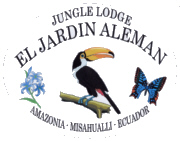|
|
|
 |
|
|
|||||||||||||||||
|
JUNGLE LODGE EL JARDIN ALEMAN was opened in January 1996 and is surrounded by 125 ha protected primary and secondary rainforest. Apart from the hotel grounds, belongs to the Lodge 100 ha protected rainforest on the banks of the Napo River. The resort is built on 5 ha. The Lodge is located on the banks of Misahuallí River, a tributary of Napo River , which forms after about 1400 km, in Perú, the Amazon. These rivers are so called White Waters. That means that they or their tributaries rise in the Andes Mountains and they always carry sediments along. This is also why they are relatively eutrophic and they look muddy and dirty because of the stirred up sediments. The opposite is Black Water. These rivers or lakes rise in the Amazon Basin by ground or rainwater; because of weathering of plants, they are very acid and dark, but clear and oligotrophic water.
Here at the foot of the Andes the altitude is about
450 meter. It falls a lot of rain, from 3500 to 4000
mm per year. There are no marked seasons
because of
nearby equator. The rainfalls are spread equally
over all the year; but specially from June to
November.
The temperature is in between 15-18° C by night
and
28-33 C during day.
During rainy season the jungle is most
attractive and the rivers are most navigable.
Clothing is the same all the year: light,
cotton clothes, long pants and long-sleeved shirts
for the jungle walks, sun hats and sunglasses
indispensable. (Rubber boots you get in your
Lodge).
Don't forget your photo camera!
The plants, which will be presented by your guide during the jungle tours can only be a part of the unbelievable botanical diversity of the Amazon region. They are chosen because of their importance and utilization as food, medicinal plant, colouring, drug or building material for the natives.
I. We minimize environmental impacts
II. Our
efforts to conserve environment and to contribute
|